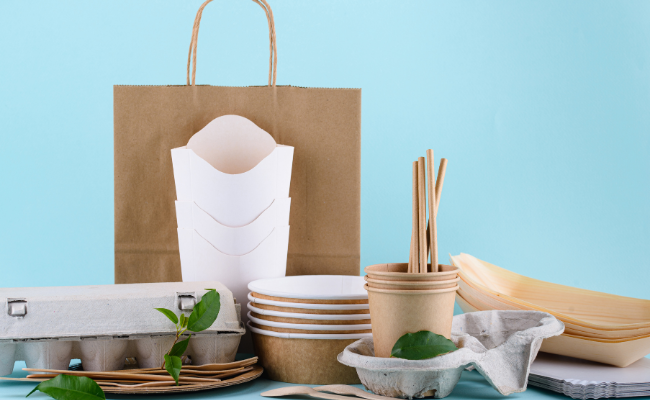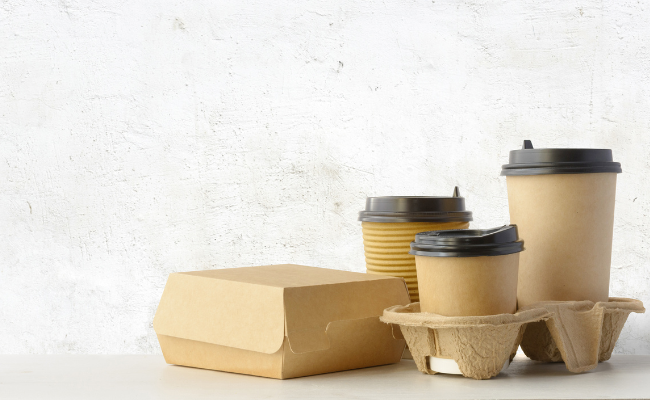The Imperative Role of Sustainable Packaging in the Food Service Industry
In the bustling realm of the food service industry, one often overlooked element is the packaging. It’s the silent partner in every transaction, the unsung hero that keeps food safe, fresh, and appetizing. But as we navigate the 21st century, the spotlight is increasingly falling on this essential component. The question is no longer just about functionality but sustainability.
How can we ensure that the packaging we use today doesn’t compromise the health of our planet tomorrow? This article delves into the importance of sustainable packaging in the food service industry, its environmental benefits, and the regulations guiding its use.
The Environmental Benefits of Sustainable Packaging
 Sustainable packaging is more than just a buzzword—it’s a necessity. The environmental benefits are manifold, starting with the reduction of waste.
Sustainable packaging is more than just a buzzword—it’s a necessity. The environmental benefits are manifold, starting with the reduction of waste.
Traditional packaging materials, particularly single-use plastics, contribute significantly to global waste. According to the United Nations, 300 million tons of plastic waste is produced every year, a staggering amount that’s nearly equivalent to the weight of the entire human population. Fortunately, sustainable packaging from recyclable, compostable, or biodegradable materials can drastically reduce this figure.
Moreover, sustainable packaging conserves resources. Traditional packaging materials like plastic come from non-renewable sources such as petroleum. In contrast, sustainable packaging materials are from renewable resources like plant-based bioplastics, recycled paper, and bamboo. This shift reduces our reliance on finite resources and decreases the energy required for production.
Lastly, sustainable packaging plays a vital role in combating climate change. The production and disposal of traditional packaging materials release greenhouse gasses, contributing to global warming. Sustainable packaging, with its emphasis on recyclable and compostable materials, results in lower carbon emissions, helping mitigate the effects of climate change.
Exploring Sustainable Packaging Materials

Bioplastics and Compostable Materials
Bioplastics represent a significant stride toward sustainable packaging. These come from renewable resources, marking a departure from conventional plastics that rely on non-renewable petroleum-based sources. Using renewable resources in packaging material production is a game-changer as it curbs the depletion of finite natural resources.
Examples of bioplastics are aplenty. Polylactic Acid (PLA), a bioplastic derived from corn starch or sugarcane, is a popular choice in the food service industry. It mirrors the properties of traditional plastic, offering clarity and strength but with the added advantage of being compostable.
Another example is Polyhydroxyalkanoates (PHA), biodegradable plastics produced by bacterial fermentation of sugar or lipids. They are used in packaging films and bags, demonstrating the versatility of bioplastics.
You may also like: Corn-Based Plastic: The Benefits of PLA for Sustainable Manufacturing and Eco-Friendly Products
Complementing bioplastics are compostable materials. These materials break down into nutrient-rich compost under specific conditions, typically in industrial composting facilities. The advantage of compostable materials is particularly evident in food service packaging.
Traditional packaging contaminated with food remnants often becomes unsuitable for recycling. However, compostable packaging is disposable along with food waste, simplifying waste management and reducing landfill.
One example of compostable material is bagasse, a by-product of sugarcane processing. Bagasse is moldable into various shapes, making it suitable for plates, bowls, and takeaway containers. Another example is PLA-lined paper, used in coffee cups and soup containers. Once composted, these materials return to the earth, completing a cycle of sustainability.
Recyclable Packaging

Recyclable materials are diverse, ranging from paper and cardboard to metals and certain types of plastic. For instance, Polyethylene Terephthalate (PET) is a highly recyclable type of plastic common in beverage bottles. Post-consumer PET can be recycled into a variety of products, including new bottles, clothing, and even furniture.
Aluminum in cans and foil is another recyclable material. It can be recycled indefinitely without losing its properties, making it a highly sustainable choice for food packaging.
The exploration of sustainable packaging materials reveals a world of possibilities. From bioplastics and compostable materials to recyclable packaging, these materials offer viable alternatives to traditional packaging. They represent the future of packaging, a future where sustainability is not an afterthought but an integral part of the design and production process.
Regulations and Standards for Sustainable Food Packaging
As the importance of sustainable packaging becomes increasingly recognized, regulations and standards have been established to guide its implementation.
In the United States, the Federal Trade Commission (FTC) provides guidelines on environmental marketing claims, including those related to packaging. These guidelines, known as the Green Guides, help ensure that claims about recyclability, compostability, and other environmental benefits are accurate and not misleading.
In addition to federal regulations, several states have implemented their own regulations. For instance, California’s Sustainable Packaging for the State of California Act requires food service packaging used at state facilities to be recyclable or compostable. These regulations not only promote the use of sustainable packaging but also encourage innovation in the field.
Conclusion
The shift toward sustainable packaging in the food service industry is not just a passing trend but a necessity to ensure the planet’s survival. As we grapple with the environmental challenges of our time, every aspect of our economy must be scrutinized for its sustainability, and food service packaging is no exception. With its potential to reduce waste, conserve resources, and combat climate change, sustainable packaging holds the key to a more sustainable future for the food service industry.
As we move forward, it’s crucial that businesses, consumers, and policymakers recognize the importance of sustainable packaging. It’s not just about making the right choice for the environment, but also for the long-term viability of the food service industry. After all, a future where food service thrives in harmony with the planet is a future worth packaging for.

